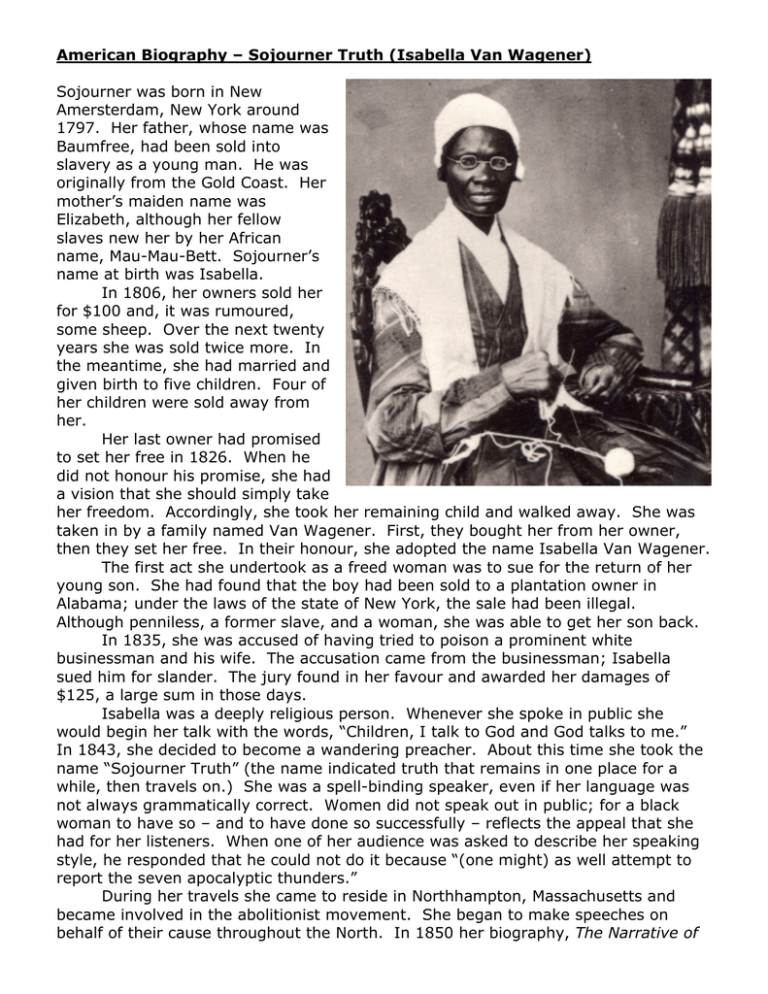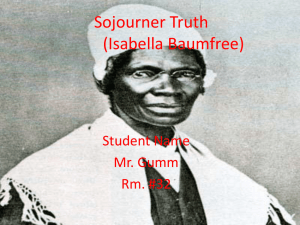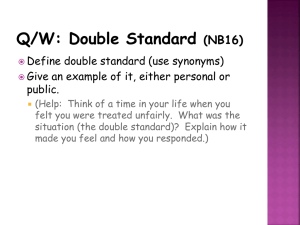American Biography – Sojourner Truth (Isabella Van Wagener)
advertisement

American Biography – Sojourner Truth (Isabella Van Wagener) Sojourner was born in New Amersterdam, New York around 1797. Her father, whose name was Baumfree, had been sold into slavery as a young man. He was originally from the Gold Coast. Her mother’s maiden name was Elizabeth, although her fellow slaves new her by her African name, Mau-Mau-Bett. Sojourner’s name at birth was Isabella. In 1806, her owners sold her for $100 and, it was rumoured, some sheep. Over the next twenty years she was sold twice more. In the meantime, she had married and given birth to five children. Four of her children were sold away from her. Her last owner had promised to set her free in 1826. When he did not honour his promise, she had a vision that she should simply take her freedom. Accordingly, she took her remaining child and walked away. She was taken in by a family named Van Wagener. First, they bought her from her owner, then they set her free. In their honour, she adopted the name Isabella Van Wagener. The first act she undertook as a freed woman was to sue for the return of her young son. She had found that the boy had been sold to a plantation owner in Alabama; under the laws of the state of New York, the sale had been illegal. Although penniless, a former slave, and a woman, she was able to get her son back. In 1835, she was accused of having tried to poison a prominent white businessman and his wife. The accusation came from the businessman; Isabella sued him for slander. The jury found in her favour and awarded her damages of $125, a large sum in those days. Isabella was a deeply religious person. Whenever she spoke in public she would begin her talk with the words, “Children, I talk to God and God talks to me.” In 1843, she decided to become a wandering preacher. About this time she took the name “Sojourner Truth” (the name indicated truth that remains in one place for a while, then travels on.) She was a spell-binding speaker, even if her language was not always grammatically correct. Women did not speak out in public; for a black woman to have so – and to have done so successfully – reflects the appeal that she had for her listeners. When one of her audience was asked to describe her speaking style, he responded that he could not do it because “(one might) as well attempt to report the seven apocalyptic thunders.” During her travels she came to reside in Northhampton, Massachusetts and became involved in the abolitionist movement. She began to make speeches on behalf of their cause throughout the North. In 1850 her biography, The Narrative of Sojourner Truth, was written by an abolitionist. Members of the movement sold it at their meetings to finance their cause. After the Civil War broke out, she traveled throughout the North to raise supplies for black Union regiments. When the Civil War had been won, she worked with freed slaves to find their children who had been kidnapped and sold into slavery. She also took a leading part in the desegregation of the streetcars of Washington D.C. She also tried to establish settlements for freed Blacks in Kansas and Missouri. As well, she became involved in the movement for Women’s Rights. She described herself as “A Self-Made Woman”. At a meeting of the American Equal Rights Association she expressed her beliefs: “There is a great stir about colored men getting their rights, but not a word about the colored women; and if colored men get their rights, and not colored women theirs, you see the colored will be masters over the women, and it will be just as bad as it was before…I am above eighty years old; it is about time for me to be going. I have been forty years a slave and forty years free, and would be here forty years more to have equal rights for all. I am kept here because something remains for me to do; I suppose I am yet to help break the chain. I have done a great deal of work; as much as a man, but did not get so much pay. I used to work in the field and bind grain, keeping with the cradler; but men doing no more, got twice as much pay…I suppose that I am the only colored woman that goes about to speak for the rights of the colored woman. I want to keep the thing stirring, now that the ice is cracked…” Despite her pleas, only black men were given the right to vote; women, black or white, did not receive the right to vote until 1920. What did Sojourner Truth accomplish for herself, for her family, for black Americans, and for women?





